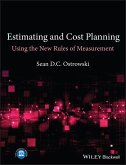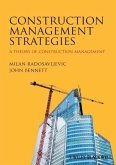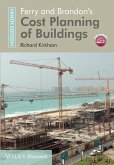Design Economics for the Built Environment
Impact of Sustainability on Project Evaluation
Herausgeber: Robinson, Herbert; Ilozor, Ben; Gilbertson, Barry; Symonds, Barry
Design Economics for the Built Environment
Impact of Sustainability on Project Evaluation
Herausgeber: Robinson, Herbert; Ilozor, Ben; Gilbertson, Barry; Symonds, Barry
- Broschiertes Buch
- Merkliste
- Auf die Merkliste
- Bewerten Bewerten
- Teilen
- Produkt teilen
- Produkterinnerung
- Produkterinnerung
The drive towards environmentally friendly buildings and infrastructure has led to a
growing interest in providing design solutions underpinned by the core principles of sustainability to balance economic, social and environmental factors.
Design Economics for the Built Environment: Impact of sustainability on project evaluation presents new directions, reflecting the need to recognise the impact of climate change and the
importance of sustainability in project evaluation. The aim is to provide a new approach to
understanding design economics in the context of the changing…mehr
![Estimating and Cost Planning Using the New Rules of Measurement Estimating and Cost Planning Using the New Rules of Measurement]() Sean D. C. OstrowskiEstimating and Cost Planning Using the New Rules of Measurement68,99 €
Sean D. C. OstrowskiEstimating and Cost Planning Using the New Rules of Measurement68,99 €![Measurement Using the New Rules of Measurement Measurement Using the New Rules of Measurement]() Sean D. C. OstrowskiMeasurement Using the New Rules of Measurement69,99 €
Sean D. C. OstrowskiMeasurement Using the New Rules of Measurement69,99 €![Cost Management of Construction Projects Cost Management of Construction Projects]() Donald ToweyCost Management of Construction Projects73,99 €
Donald ToweyCost Management of Construction Projects73,99 €![Value Management of Construction Projects Value Management of Construction Projects]() John KellyValue Management of Construction Projects92,99 €
John KellyValue Management of Construction Projects92,99 €![Construction Management Strategies Construction Management Strategies]() Milan RadosavljevicConstruction Management Strategies66,99 €
Milan RadosavljevicConstruction Management Strategies66,99 €![Ferry and Brandon's Cost Planning of Buildings Ferry and Brandon's Cost Planning of Buildings]() Richard KirkhamFerry and Brandon's Cost Planning of Buildings45,99 €
Richard KirkhamFerry and Brandon's Cost Planning of Buildings45,99 €![An Employer's and Engineer's Guide to the Fidic Conditions of Contract An Employer's and Engineer's Guide to the Fidic Conditions of Contract]() Michael D. RobinsonAn Employer's and Engineer's Guide to the Fidic Conditions of Contract121,99 €
Michael D. RobinsonAn Employer's and Engineer's Guide to the Fidic Conditions of Contract121,99 €-
-
-
growing interest in providing design solutions underpinned by the core principles of sustainability to balance economic, social and environmental factors.
Design Economics for the Built Environment: Impact of sustainability on project evaluation presents new directions, reflecting the need to recognise the impact of climate change and the
importance of sustainability in project evaluation. The aim is to provide a new approach to
understanding design economics in the context of the changing policy
environment, legislative and regulatory framework, and increasing economic,
environmental and social pressure as result of the sustainability agenda.
The book follows a structured approach from theories and principles in the earlier chapters,
to the practical applications and emerging techniques focusing on value and
social, economic and environmental considerations in making design decisions. It
starts with the policy context, building on various theories and principles
such as, capital cost, value of design and resource-based theories, the new rules of measurement (NRM) to explore cost planning, the relationship between height and costs, key
socio-economic and environmental variables for design appraisal, eco-cost/value ratio (EVR), whole life theory
and the treatment of carbon emission as external costs, productivity and
efficiency, fiscal drivers and legal framework for carbon reduction, procurement and allocation of risks in contracts.
Case studies, practical examples and frameworks throughout reinforce theories and
principles and relate them to current practice. The book is essential reading
for postgraduate students in architecture, building and quantity surveying and
is also a valuable resource for academics, consultants and policy-makers in the
built environment.
- Produktdetails
- Verlag: Wiley & Sons
- 1. Auflage
- Seitenzahl: 432
- Erscheinungstermin: 15. Juni 2015
- Englisch
- Abmessung: 239mm x 170mm x 20mm
- Gewicht: 794g
- ISBN-13: 9780470659090
- ISBN-10: 0470659092
- Artikelnr.: 41429596
- Verlag: Wiley & Sons
- 1. Auflage
- Seitenzahl: 432
- Erscheinungstermin: 15. Juni 2015
- Englisch
- Abmessung: 239mm x 170mm x 20mm
- Gewicht: 794g
- ISBN-13: 9780470659090
- ISBN-10: 0470659092
- Artikelnr.: 41429596
PRINCIPLES AND APPROACHES 1 1 Economic Context, Policy Environment and the
Changing Role of Design Economists 3 Herbert Robinson and Barry Symonds 1.1
Introduction 3 1.2 The economic context 4 1.3 Globalisation of construction
market 6 1.4 The policy environment and the construction industry 9 1.5
Current and emerging role of design economists 11 2 Theories and Principles
of Design Economics 16 Herbert Robinson and Barry Symonds 2.1 Introduction
16 2.2 Factors affecting design costs and benefits 17 2.3 Capital cost
theory 18 2.4 Whole life cost theory 21 2.5 Value management theory 23 2.6
Value of design theory 24 2.7 Carter's model 26 2.8 Resource?]based theory
27 3 New Approaches and Rules of Measurement for Cost Estimating and
Planning 31 Barry Symonds, Peter Barnes and Herbert Robinson 3.1
Introduction 31 3.2 The standardisation of cost estimating 32 3.3 The RICS
NRM 1 33 3.4 RIBA plan of work, RICS estimating, cost planning and NRM 1 34
3.5 Cost estimating and cost planning 35 3.6 Elemental Standard Form of
Cost Analysis (SFCA) 40 3.7 Benchmarking (cost limits) 41 3.8 Building
information modelling 43 3.9 Concluding remarks 44 4 The Relationship
between Building Height and Construction Costs 47 David Picken and Benedict
Ilozor 4.1 Introduction 47 4.2 Research in the 1970s and 1980s 48 4.3 More
recent research in Hong Kong and Shanghai 50 4.4 Conclusions 59 5 Appraisal
of Design to Determine Viability of Development Schemes 61 Herbert Robinson
5.1 Introduction 61 5.2 Assessing costs and benefits of design alternatives
61 5.3 Appraisal of design using discounting methods 63 5.4 Appraisal of
design using residual technique 65 5.5 Case study of the blackfriars
development project 69 5.6 Concluding remarks 77 6 Eco-cost Associated with
Tall Buildings 80 Peter de Jong and J.W.F. Hans Wamelink 6.1 Introduction
80 6.2 Overview of the Dutch housing market and land use planning 80 6.3
Eco-costs/value ratio and the EVR model 82 6.4 Applying the EVR model to
housing 86 6.5 EVR and tall buildings 88 6.6 Embedding EVR in other
sustainable ranking methods 89 6.7 Conclusion 90 7 Productivity in
Construction Projects 93 Shamil Naoum 7.1 Introduction 93 7.2 Concept and
measurement of productivity 94 7.3 Previous literature on factors affecting
site productivity 94 7.4 Productivity survey 100 7.5 Proposed framework for
site productivity 102 7.6 Conclusion and further research 104 8 Design
Variables and Whole-Life Cost Modelling 107 Andrea Pelzeter 8.1
Introduction 107 8.2 Whole-life cost modelling 108 8.3 Steps in LCC
modelling 110 8.4 Design principles to optimise lcc 112 8.5 A worked
example of an office façade 116 8.6 Inclusion of carbon emissions into wlc
modelling 118 8.7 Limitations of wlc 119 8.8 Concluding remarks 119 9
Procurement and Contract Strategy: Risks Allocation and Construction Cost
121 John Adriaanse and Herbert Robinson 9.1 Introduction 121 9.2
Procurement strategy and contract selection 122 9.3 Wembley stadium case
study 123 9.4 Allocation of risks and forms of contract 124 9.5 Risks and
construction costs 125 9.6 Procurement systems and contract issues 128 9.7
Alternative forms of procurement 133 9.8 Concluding remarks 135 10
Sustainable Design, Investment and Value 137 Thomas Lützkendorf and David
Lorenz 10.1 Introduction 137 10.2 Formulation of project goals 138 10.3
Identifying value-related characteristics 142 10.4 The performance approach
143 10.5 Use of sustainability assessment systems 146 10.6 Relationship
between sustainable credentials and value 148 10.7 Concluding remarks 150
11 Carbon Reduction and Fiscal Incentives for Sustainable Design 152 Paul
Farey 11.1 Introduction 152 11.2 Key drivers of owners and occupiers 153
11.3 Reducing demand for energy in buildings 153 11.4 Fiscal drivers 155
11.5 Reliefs and allowances 161 11.6 Subsidies and incentives 173 11.7
Conclusion 175 12 Environmental Assessment Tools: An Overview of the UK's
BREEAM and the US's LEED 177 Ina Colombo, Benedict Ilozor and Herbert
Robinson 12.1 Introduction 177 12.2 Context and the need to design to
reduce carbon emission 178 12.3 Key features of environmental assessment
tools 179 12.4 The Breeam tool 180 12.5 The LEED tool 184 12.6 Concluding
remarks 190 13 Space Planning and Organisational Performance 191 Benedict
Ilozor 13.1 Introduction 191 13.2 Organisational performance and innovative
work settings 192 13.3 Hypotheses and test results 193 13.4 Discussion 195
13.5 Conclusions 198 14 Achieving Zero Carbon in Sustainable Communities
201 Malgorzata Jacewicz and Herbert Robinson 14.1 Introduction 201 14.2 Key
concepts and principles 202 14.3 Key features of decentralised energy
networks 203 14.4 Activity-based design approach 204 14.5 Key steps in the
design process 206 14.6 Evaluating energy, space and land requirements 209
14.7 Concluding remarks 211 15 Flood Risk Mitigation: Design Considerations
and Cost Implications for New and Existing Buildings 213 Rotimi Joseph,
David Proverbs and Jessica Lamond 15.1 Introduction 213 15.2 Increasing
challenges of flooding due to global warming and urban development 214 15.3
Flood mitigation 215 15.4 Flood mitigation consideration for new buildings
at design stage 218 15.5 Implications of mitigation measures in terms of
building cost 218 15.6 Implications of mitigation measures in terms of
property value and insurance cost 222 15.7 Conclusions 224 PART II INDUSTRY
PERSPECTIVE, CASE STUDIES AND IMPLICATIONS FOR CURRICULUM DEVELOPMENT 227
16 Reusing Knowledge and Leveraging Technology to Reduce Design and
Construction Costs 229 Herbert Robinson and Chika Udeaja 16.1 Introduction
229 16.2 Knowledge reuse in construction processes and projects 229 16.3
Knowledge reuse in construction projects 231 16.4 Leveraging knowledge
systems to reduce time and costs 232 16.5 4Projects knowledge solution 234
16.6 Case studies and discussions 235 16.7 Concluding remarks 237 17
Sustainable Design Economics and Property Valuation: An Industry
Perspective 240 Barry Gilbertson, Ann Heywood, Ian Selby and John
Symes-Thompson 17.1 Introduction 240 17.2 Sustainable design economics and
property valuation 240 17.3 Data collection 243 17.4 UK government impact
244 17.5 The valuation process 245 17.6 Conclusion 247 18 Cost Planning of
Construction Projects: An Industry Perspective 248 Jon Scott 18.1
Introduction 248 18.2 Concept and format of a cost plan 248 18.3 How a cost
plan is put together 253 18.4 How the cost plan evolves through the riba
design stages 255 18.5 Main factors that affect the overall cost of a
building 257 18.6 Impact of sustainability on cost plans 258 18.7 Recent
developments in BIM and the implications for cost planning 260 18.8
Conclusion 260 19 Life Cycle Costing and Sustainability Assessments: An
Industry Perspective with Case Studies 262 Sean Lockie 19.1 Introduction
262 19.2 Sustainability considerations in design 263 19.3 Using the life
cycle costing standards 269 19.4 Case study 1 - whole building 275 19.5
Case study 2 - lighting 279 19.6 Concluding remarks 282 20 Designing
Super-Tall Buildings for Increased Resilience: New Measures and Cost
Considerations 284 James Hayhoe 20.1 Introduction 284 20.2 Challenges of
tall buildings and the need for increased resilience 284 20.3 Factors
influencing design and cost of tall buildings 285 20.4 Design of
counter-terrorism measures 288 20.5 Cost of new measures and design 291
20.6 Concluding remarks 295 21 Building Information Modelling: A New
Approach to Design, Quantification, Costing, and Schedule Management with
Case Studies 299 Aviad Almagor and Barry Symonds 21.1 Introduction 299 21.2
Concept of Bim 300 21.3 Integration and dataflow 302 21.4 Model Progression
Specification: Developing a common language 303 21.5 Quality 305 21.6 Cost
planning 310 21.7 Construction schedule 314 21.8 Conclusion and future
directions 317 22 Case Study: Value Engineering and Management Focusing on
Groundworks and Piling Packages 319 Richard Powell 22.1 Introduction 319
22.2 Why VM? 319 22.3 When and where is VM applied? 320 22.4 Value
management implemention and tools used 320 22.5 Practical benefits and
savings 324 22.6 Reflection and concluding remarks 327 23 Case Study: Value
Engineering of a New Office Development with Retail Provision 330 Paul
Ullmer 23.1 Introduction 330 23.2 Why value management? 330 23.3 When and
where is value management applied? 331 23.4 Value management implementation
and tools used 332 23.5 Practical benefits and savings 334 23.6 Concluding
remarks 335 24 Case Studies: Sustainable Design, Innovation and
Competitiveness in Construction Firms 336 Arthlene Amos and Herbert
Robinson 24.1 Introduction 336 24.2 Background and context 336 24.3 Key
drivers of sustainability in design and construction 337 24.4 Case studies
339 24.5 Findings and discussions 340 24.6 Concluding Remarks 353 25 Case
Study: Retrofitting Building Services Design and Sustainability in Star
Island 356 Victoria Hardy 25.1 Introduction 356 25.2 Initial study or
analysis to identify problems 357 25.3 Funding for capital improvement plan
358 25.4 Evaluation of design options and the cost implications 358 25.5
Proposed design solution and costs 359 25.6 Concluding remarks 361 26 Case
Studies: Maximising Design and Construction Opportunities through Fiscal
Incentives 362 Paul Farey 26.1 Introduction 362 26.2 Strategic
considerations 362 26.3 Capital allowances planning 364 26.4 Enhanced
capital allowances (ECA) 366 26.5 Land remediation relief (LRR) 367 26.6
Value added tax 368 26.7 Taxation anti-avoidance 370 26.8 Conclusion 370 27
Mapping Sustainability in the Quantity Surveying Curriculum: Educating
Tomorrow's Design Economists 372 Chika Udeaja, Damilola Ekundayo, Lei Zhou,
John Pearson and Srinath Perera 27.1 Introduction 372 27.2 Literature
review on sustainability issues 373 27.3 Development of the Sustainability
Framework 376 27.4 Mapping of Sustainability Education in QS Degree
Programmes 380 27.5 Discussion and conclusions 382 Appendix A: UK Property
Investment Yields (December 2013) 387 Appendix B: IPD/RICS Sustainability
Inspection Checklist 2014 389 Index 392
PRINCIPLES AND APPROACHES 1 1 Economic Context, Policy Environment and the
Changing Role of Design Economists 3 Herbert Robinson and Barry Symonds 1.1
Introduction 3 1.2 The economic context 4 1.3 Globalisation of construction
market 6 1.4 The policy environment and the construction industry 9 1.5
Current and emerging role of design economists 11 2 Theories and Principles
of Design Economics 16 Herbert Robinson and Barry Symonds 2.1 Introduction
16 2.2 Factors affecting design costs and benefits 17 2.3 Capital cost
theory 18 2.4 Whole life cost theory 21 2.5 Value management theory 23 2.6
Value of design theory 24 2.7 Carter's model 26 2.8 Resource?]based theory
27 3 New Approaches and Rules of Measurement for Cost Estimating and
Planning 31 Barry Symonds, Peter Barnes and Herbert Robinson 3.1
Introduction 31 3.2 The standardisation of cost estimating 32 3.3 The RICS
NRM 1 33 3.4 RIBA plan of work, RICS estimating, cost planning and NRM 1 34
3.5 Cost estimating and cost planning 35 3.6 Elemental Standard Form of
Cost Analysis (SFCA) 40 3.7 Benchmarking (cost limits) 41 3.8 Building
information modelling 43 3.9 Concluding remarks 44 4 The Relationship
between Building Height and Construction Costs 47 David Picken and Benedict
Ilozor 4.1 Introduction 47 4.2 Research in the 1970s and 1980s 48 4.3 More
recent research in Hong Kong and Shanghai 50 4.4 Conclusions 59 5 Appraisal
of Design to Determine Viability of Development Schemes 61 Herbert Robinson
5.1 Introduction 61 5.2 Assessing costs and benefits of design alternatives
61 5.3 Appraisal of design using discounting methods 63 5.4 Appraisal of
design using residual technique 65 5.5 Case study of the blackfriars
development project 69 5.6 Concluding remarks 77 6 Eco-cost Associated with
Tall Buildings 80 Peter de Jong and J.W.F. Hans Wamelink 6.1 Introduction
80 6.2 Overview of the Dutch housing market and land use planning 80 6.3
Eco-costs/value ratio and the EVR model 82 6.4 Applying the EVR model to
housing 86 6.5 EVR and tall buildings 88 6.6 Embedding EVR in other
sustainable ranking methods 89 6.7 Conclusion 90 7 Productivity in
Construction Projects 93 Shamil Naoum 7.1 Introduction 93 7.2 Concept and
measurement of productivity 94 7.3 Previous literature on factors affecting
site productivity 94 7.4 Productivity survey 100 7.5 Proposed framework for
site productivity 102 7.6 Conclusion and further research 104 8 Design
Variables and Whole-Life Cost Modelling 107 Andrea Pelzeter 8.1
Introduction 107 8.2 Whole-life cost modelling 108 8.3 Steps in LCC
modelling 110 8.4 Design principles to optimise lcc 112 8.5 A worked
example of an office façade 116 8.6 Inclusion of carbon emissions into wlc
modelling 118 8.7 Limitations of wlc 119 8.8 Concluding remarks 119 9
Procurement and Contract Strategy: Risks Allocation and Construction Cost
121 John Adriaanse and Herbert Robinson 9.1 Introduction 121 9.2
Procurement strategy and contract selection 122 9.3 Wembley stadium case
study 123 9.4 Allocation of risks and forms of contract 124 9.5 Risks and
construction costs 125 9.6 Procurement systems and contract issues 128 9.7
Alternative forms of procurement 133 9.8 Concluding remarks 135 10
Sustainable Design, Investment and Value 137 Thomas Lützkendorf and David
Lorenz 10.1 Introduction 137 10.2 Formulation of project goals 138 10.3
Identifying value-related characteristics 142 10.4 The performance approach
143 10.5 Use of sustainability assessment systems 146 10.6 Relationship
between sustainable credentials and value 148 10.7 Concluding remarks 150
11 Carbon Reduction and Fiscal Incentives for Sustainable Design 152 Paul
Farey 11.1 Introduction 152 11.2 Key drivers of owners and occupiers 153
11.3 Reducing demand for energy in buildings 153 11.4 Fiscal drivers 155
11.5 Reliefs and allowances 161 11.6 Subsidies and incentives 173 11.7
Conclusion 175 12 Environmental Assessment Tools: An Overview of the UK's
BREEAM and the US's LEED 177 Ina Colombo, Benedict Ilozor and Herbert
Robinson 12.1 Introduction 177 12.2 Context and the need to design to
reduce carbon emission 178 12.3 Key features of environmental assessment
tools 179 12.4 The Breeam tool 180 12.5 The LEED tool 184 12.6 Concluding
remarks 190 13 Space Planning and Organisational Performance 191 Benedict
Ilozor 13.1 Introduction 191 13.2 Organisational performance and innovative
work settings 192 13.3 Hypotheses and test results 193 13.4 Discussion 195
13.5 Conclusions 198 14 Achieving Zero Carbon in Sustainable Communities
201 Malgorzata Jacewicz and Herbert Robinson 14.1 Introduction 201 14.2 Key
concepts and principles 202 14.3 Key features of decentralised energy
networks 203 14.4 Activity-based design approach 204 14.5 Key steps in the
design process 206 14.6 Evaluating energy, space and land requirements 209
14.7 Concluding remarks 211 15 Flood Risk Mitigation: Design Considerations
and Cost Implications for New and Existing Buildings 213 Rotimi Joseph,
David Proverbs and Jessica Lamond 15.1 Introduction 213 15.2 Increasing
challenges of flooding due to global warming and urban development 214 15.3
Flood mitigation 215 15.4 Flood mitigation consideration for new buildings
at design stage 218 15.5 Implications of mitigation measures in terms of
building cost 218 15.6 Implications of mitigation measures in terms of
property value and insurance cost 222 15.7 Conclusions 224 PART II INDUSTRY
PERSPECTIVE, CASE STUDIES AND IMPLICATIONS FOR CURRICULUM DEVELOPMENT 227
16 Reusing Knowledge and Leveraging Technology to Reduce Design and
Construction Costs 229 Herbert Robinson and Chika Udeaja 16.1 Introduction
229 16.2 Knowledge reuse in construction processes and projects 229 16.3
Knowledge reuse in construction projects 231 16.4 Leveraging knowledge
systems to reduce time and costs 232 16.5 4Projects knowledge solution 234
16.6 Case studies and discussions 235 16.7 Concluding remarks 237 17
Sustainable Design Economics and Property Valuation: An Industry
Perspective 240 Barry Gilbertson, Ann Heywood, Ian Selby and John
Symes-Thompson 17.1 Introduction 240 17.2 Sustainable design economics and
property valuation 240 17.3 Data collection 243 17.4 UK government impact
244 17.5 The valuation process 245 17.6 Conclusion 247 18 Cost Planning of
Construction Projects: An Industry Perspective 248 Jon Scott 18.1
Introduction 248 18.2 Concept and format of a cost plan 248 18.3 How a cost
plan is put together 253 18.4 How the cost plan evolves through the riba
design stages 255 18.5 Main factors that affect the overall cost of a
building 257 18.6 Impact of sustainability on cost plans 258 18.7 Recent
developments in BIM and the implications for cost planning 260 18.8
Conclusion 260 19 Life Cycle Costing and Sustainability Assessments: An
Industry Perspective with Case Studies 262 Sean Lockie 19.1 Introduction
262 19.2 Sustainability considerations in design 263 19.3 Using the life
cycle costing standards 269 19.4 Case study 1 - whole building 275 19.5
Case study 2 - lighting 279 19.6 Concluding remarks 282 20 Designing
Super-Tall Buildings for Increased Resilience: New Measures and Cost
Considerations 284 James Hayhoe 20.1 Introduction 284 20.2 Challenges of
tall buildings and the need for increased resilience 284 20.3 Factors
influencing design and cost of tall buildings 285 20.4 Design of
counter-terrorism measures 288 20.5 Cost of new measures and design 291
20.6 Concluding remarks 295 21 Building Information Modelling: A New
Approach to Design, Quantification, Costing, and Schedule Management with
Case Studies 299 Aviad Almagor and Barry Symonds 21.1 Introduction 299 21.2
Concept of Bim 300 21.3 Integration and dataflow 302 21.4 Model Progression
Specification: Developing a common language 303 21.5 Quality 305 21.6 Cost
planning 310 21.7 Construction schedule 314 21.8 Conclusion and future
directions 317 22 Case Study: Value Engineering and Management Focusing on
Groundworks and Piling Packages 319 Richard Powell 22.1 Introduction 319
22.2 Why VM? 319 22.3 When and where is VM applied? 320 22.4 Value
management implemention and tools used 320 22.5 Practical benefits and
savings 324 22.6 Reflection and concluding remarks 327 23 Case Study: Value
Engineering of a New Office Development with Retail Provision 330 Paul
Ullmer 23.1 Introduction 330 23.2 Why value management? 330 23.3 When and
where is value management applied? 331 23.4 Value management implementation
and tools used 332 23.5 Practical benefits and savings 334 23.6 Concluding
remarks 335 24 Case Studies: Sustainable Design, Innovation and
Competitiveness in Construction Firms 336 Arthlene Amos and Herbert
Robinson 24.1 Introduction 336 24.2 Background and context 336 24.3 Key
drivers of sustainability in design and construction 337 24.4 Case studies
339 24.5 Findings and discussions 340 24.6 Concluding Remarks 353 25 Case
Study: Retrofitting Building Services Design and Sustainability in Star
Island 356 Victoria Hardy 25.1 Introduction 356 25.2 Initial study or
analysis to identify problems 357 25.3 Funding for capital improvement plan
358 25.4 Evaluation of design options and the cost implications 358 25.5
Proposed design solution and costs 359 25.6 Concluding remarks 361 26 Case
Studies: Maximising Design and Construction Opportunities through Fiscal
Incentives 362 Paul Farey 26.1 Introduction 362 26.2 Strategic
considerations 362 26.3 Capital allowances planning 364 26.4 Enhanced
capital allowances (ECA) 366 26.5 Land remediation relief (LRR) 367 26.6
Value added tax 368 26.7 Taxation anti-avoidance 370 26.8 Conclusion 370 27
Mapping Sustainability in the Quantity Surveying Curriculum: Educating
Tomorrow's Design Economists 372 Chika Udeaja, Damilola Ekundayo, Lei Zhou,
John Pearson and Srinath Perera 27.1 Introduction 372 27.2 Literature
review on sustainability issues 373 27.3 Development of the Sustainability
Framework 376 27.4 Mapping of Sustainability Education in QS Degree
Programmes 380 27.5 Discussion and conclusions 382 Appendix A: UK Property
Investment Yields (December 2013) 387 Appendix B: IPD/RICS Sustainability
Inspection Checklist 2014 389 Index 392








